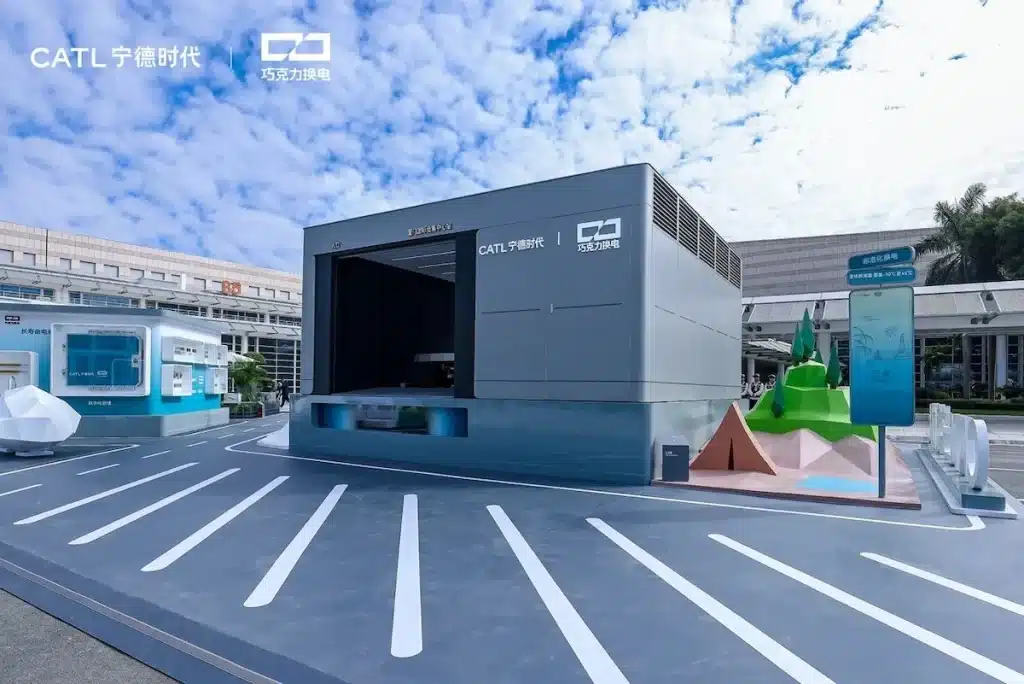China’s battery giant CATL has now deployed 400 battery swap stations for passenger electric vehicles (EVs), reinforcing its aggressive push into a segment long debated for its economic and technical viability. The company aims to expand that figure to 1,000 stations by year-end, indicating a sharp acceleration in infrastructure rollout at a time when alternative charging models are under increasing scrutiny.
CATL’s pivot toward battery swapping comes as the company continues to post strong financials. Its second-quarter net income rose to 16.6 billion yuan (€2 billion), marking a 34% increase year-over-year. These gains, however, are not solely from its established lithium-ion supply business. Instead, CATL is increasingly positioning battery swapping as a parallel pillar of its strategy—one with the potential to reshape energy distribution models for electric mobility.
Unlike conventional plug-in EV charging, battery swapping decouples vehicle ownership from battery ownership. Drivers lease standardised battery modules, which are exchanged in minutes at dedicated stations. This model offers key operational advantages—reduced charging downtime, lower upfront vehicle cost, and the ability to centrally manage battery health and lifecycle—but it also introduces infrastructure, compatibility, and capital expenditure challenges.
CATL has addressed the compatibility issue with its Choco-SEB system, which launched last December. The system includes two standardized battery formats—one for small EVs with wheelbases between 2.2 and 2.3 meters (20# pack), and another for mid-size EVs up to 2.9 meters (25# pack). This modular approach simplifies integration across vehicle platforms and reduces the logistical complexity of multi-model support. More than 20 swap-compatible EV models have already been released by CATL’s OEM partners, with Changan Automobile delivering the first 1,000 such vehicles in May.
The commercial vehicle segment is also part of CATL’s strategy. So far, approximately 100 battery swap stations have been deployed for heavy-duty trucks. The company plans to triple that number by the end of 2025. Commercial freight applications are often cited as an ideal use case for swapping due to tight logistics schedules and high daily energy throughput. CATL is working with partners such as Sinopec, Nio, and Didi to build out a robust ecosystem of compatible vehicles, infrastructure, and service models.
These developments reflect a broader strategic shift in China, where government policy has increasingly favored battery-swapping infrastructure. Regulatory frameworks have been adapted to facilitate interoperability and encourage public-private partnerships in high-density urban zones. CATL’s expansion plan aligns with this direction and follows the example of domestic competitor Nio, which already operates more than 2,600 swap stations across China and 60 in Europe.
Europe may be the next frontier. CATL has signaled interest in expanding its battery-swapping business to the continent, citing its potential to reduce total cost of ownership and improve battery durability through centralized management. Jiang Li, a senior executive at CATL, stated that the model could address structural cost issues in Europe’s EV market by removing the battery from the purchase equation and standardizing charging cycles for extended battery lifespan.
However, the European market presents notable hurdles. Vehicle design diversity, lack of standardization across OEMs, and regulatory fragmentation across borders complicate rollout. Additionally, Europe’s current EV ecosystem is heavily invested in plug-in charging infrastructure, from high-speed DC chargers to home-based AC charging setups. Introducing battery swapping as a complementary model would require a reconfiguration of consumer behavior, urban planning, and manufacturer strategy.
Nevertheless, CATL’s financial muscle and deep ties with global automakers position it as a formidable player capable of testing the limits of battery swapping beyond China. Its Choco-SEB modular battery packs offer a blueprint for how standardization might be introduced into a fragmented market—though success will depend not just on technology, but on coordination among policymakers, OEMs, and infrastructure operators.
As battery swapping gains traction in Asia, the question is no longer whether the model works in principle, but under what conditions it can scale—and whether markets like Europe are ready to accommodate it within their existing energy and transportation systems.





